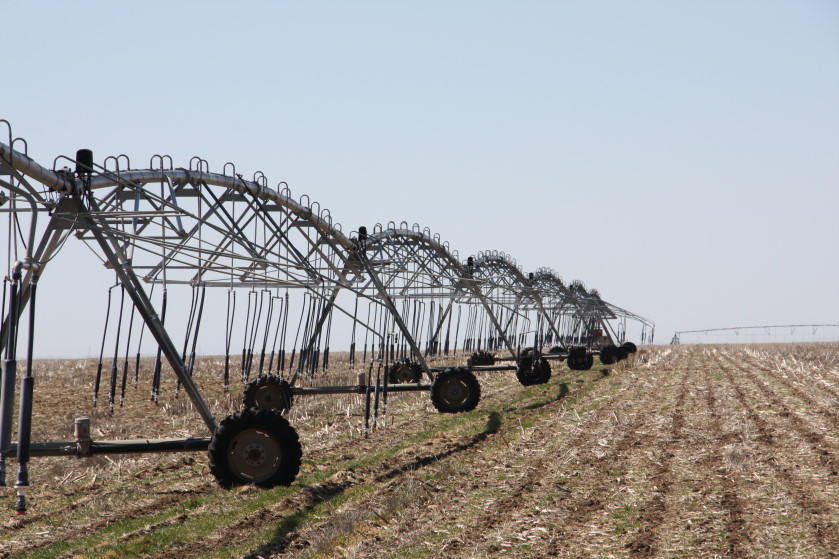
Agricultural News
With Limited Irrigation Water- How Many Acres Do You Crop?
Mon, 22 Sep 2014 15:30:51 CDT
 Getting the most value out of irrigation water is likely on the minds of many farmers across the southern Great Plains. As groundwater supplies diminish, pumping rates decline and talk of local water conservation policies surface in the region, these farmers face even more difficulty in determining how to best manage limited water.
Getting the most value out of irrigation water is likely on the minds of many farmers across the southern Great Plains. As groundwater supplies diminish, pumping rates decline and talk of local water conservation policies surface in the region, these farmers face even more difficulty in determining how to best manage limited water.
Nathan Hendricks, assistant professor of agricultural economics at Kansas State University, recently examined how the value of agricultural production declines as water availability decreases. He specifically looked at two general management methods to determine which is more effective: deficit irrigation on a larger number of acres versus more intense irrigation on a smaller number of acres.
Intensive focus on fewer acres seems to have the upper hand
To answer the question of which is better, pumping more intensively on fewer acres versus less intensively on more acres, Hendricks said he first looked at the basic economics. The question only relates to those facing limited irrigation, not those farmers who currently have limited authorized irrigated acreage and can fully irrigate that acreage.
"The simple intuition is you first want to decrease intensity and maintain acreage if a 1 percent reduction in intensity decreases returns by less than 1 percent," Hendricks said. "But, eventually as irrigation becomes more limited, you want to end up at an intensity level such that if you decreased (irrigation) intensity by 1 percent, you would decrease your returns by 1 percent."
"The economically optimal place is where either reducing intensity or reducing acreage gives you the same loss in return," he continued. "This is constant returns to intensity. Once you have reached this intensity, then it is optimal to further reduce irrigation water use by reducing acreage."
A county-level data analysis of crop production in the Great Plains and Corn Belt showed losing about 1 to 1.5 inches of precipitation short of meeting the evapotranspiration demand for crops, including corn, is about the place where water hits this constant returns to intensity, Hendricks said.
Crop water need, as defined by the Food and Agriculture Organization, is the depth of water required to meet the water loss through evapotranspiration loss of water through evaporation from the soil and transpiration from the plant. Evapotranspiration helps determine how much water is needed by rain or irrigation for crops such as corn.
"One of the key things that surprised me when I did the analysis is that's quite a bit of water per acre only being 1 to 1.5 inches short of meeting evapotranspiration demand for corn," Hendricks said. "It suggests that a pretty intense level of irrigation is optimal even when water is severely limited. As we're seeing dwindling water supplies, it will likely be optimal to start reducing irrigated acreage relatively soon."
To further illustrate, Hendricks gave an example where a farmer may choose to cut his or her irrigated acreage almost in half say 120 acres of limited irrigated corn (irrigated at half of corn evapotranspiration demand) down to 66 acres of more intensely irrigated corn (irrigated at optimal constant returns to intensity). That farmer originally had 40 acres of dryland corn, but now tacks on the remaining 54 acres of those 120 acres formerly under limited irrigation, to now equal 94 total dryland acres.
"Before, you were only doing half of corn evapotranspiration demand," he said. "It could be that you're planting wheat to do that, or whatever other crops, but the idea is that you're doing a limited intensity over a large acreage. What's optimal, according to my numbers, is that you would more intensively irrigate, but you would reduce your irrigated acreage. If you do this, you could pay another $4,260 in rent over the entire 160 acres. You're getting a lot more value by irrigating a limited area at a more intense level."
Irrigators should crunch their own numbers to figure out when they are getting below this constant returns to intensity level, Hendricks said, and then they would likely be better off reducing irrigated acreage and increasing intensity.
Policy-wise in Kansas, the role of local enhanced management areas (LEMAs) comes into play, if groundwater management districts (GMDs) decide to establish their own groundwater conservation policies. LEMAs are water conservation plans voluntarily implemented by agricultural producers, and made possible by a bill passed in the Kansas Legislature in 2012. The first LEMA in Kansas, the Sheridan-Thomas County LEMA, or Sheridan 6 LEMA, is in the northwest part of the state.
"As people are talking about LEMAs, they're thinking about reducing their water use," Hendricks said. "How are they going to adapt to less water? How can they get the most value if they're going to limit the amount of water? How will the value of agricultural production decline if they restrict their water use?"
In addition to examining how LEMAs could further affect limited irrigation, Hendricks said he would like to research further how farmers could time irrigation to get more value out of it. Perhaps they could reduce intensity more just by optimally timing irrigation.
Hendricks said he wants to know how much water farmers could reduce before they see a 10 percent decrease in water use decreasing returns by 10 percent.
"At some point we're going to hit that, my analysis suggests," he said. "I'm not exactly sure where, but that's certainly a conversation for producers. It's this idea that we can decrease water use without a huge loss in returns. Then at some point it starts to decline at a linear rate."
WebReadyTM Powered by WireReady® NSI
Top Agricultural News
More Headlines...



















